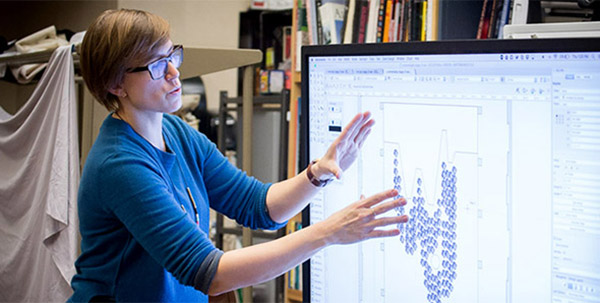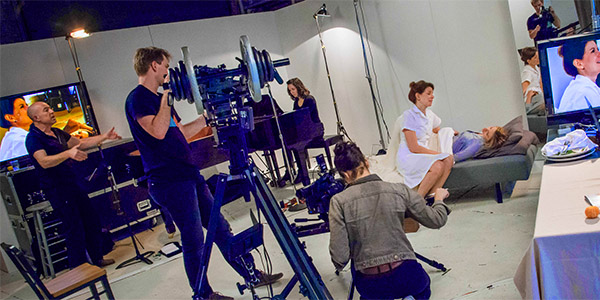COMPUTING AND AI: HUMANISTIC PERSPECTIVES FROM MIT
Theater Arts | Sara Brown

Sara Brown, MIT Assistant Professor of Theater Arts, Director of Design, MIT Theater; photo by Jon Sachs
"As a subject, artificial intelligence (AI) problematizes what it means to be human. There are an unending series of questions posed by the presence of an intelligent machine. The theater, as a synthetic art form that values and exploits liveness, is an ideal place to explore the complex and layered problems posed by AI and advanced computing."
— Sara Brown, Assistant Professor of Theater Arts, Director of Design, MIT Theater
Series | Computing and AI: Humanistic Perspectives from MIT
Sara Brown is an assistant professor for MIT Music and Theater Arts and the Director of Design for MIT Theater Arts. Her design works have been seen at the BAM Next Wave Festival, the Paris Autumn Festival, and the Minnesota Opera. Current projects include The Day at Jacob’s Pillow in Becket, Massachusetts, (US and European tours are planned) and The Prince of Providence at Trinity Repertory Company in Providence, Rhode Island.
. . .
Q: What are some examples of domain knowledge, perspectives, and methods from Theater Arts that should be integrated into the research and curriculum of the Schwarzman College of Computing and why?
An MIT student recently told me that that he found his work in computer science to be focused on finding the most efficient means to achieve a desired result. By contrast, working in the theater means leaning into inefficiencies, exploring contradictions, and rejecting the notion of a singular ideal solution to complex problems.
Already there are examples of what might have been considered efficient paths leading to unexpected results. These include algorithms that take media consumers to dark content or facial recognition software imbued with racism. In his 1949 essay “The Machine Age,” Norbert Weiner reminds us that “the machines will do what we ask them to do and not what we ought to ask them to do.”
I would never presume to know what we should ask machines to do, but I suspect that the best path forward is not always a straightforward and efficient one.
That’s why an understanding of theater can be so helpful to those forging our path in the landscape of AI, computing and other advanced technologies. Working in the theater means embracing multiple points of view. It requires that practitioners be more interested in questions than in answers. It encourages those involved to bring a healthy dose of skepticism to their assumptions. Incorporating these skills and perspectives into the Schwarzman College of Computing can equip students with the perspective they will need to ensure that what they ask machines to do and what they ought to ask machines to do are one and the same.

Persona workshop at MIT, 2015; photo by L. Barry Hetherington
Action
"Working in the theater means embracing multiple points of view. It requires that practitioners be more interested in questions than in answers. It encourages those involved to bring a healthy dose of skepticism to their assumptions. Incorporating these skills into the Schwarzman College of Computing can equip our students with the perspective they need to ensure that what they ask machines to do and what they ought to ask machines to do are one and the same."
Q: What are some of the exciting, meaningful opportunities that advanced computing is making possible in your field?
There are myriad opportunities for advanced computing to be integrated into theater, both as a tool and as a subject of exploration. As a tool, advanced computing can be used to develop performance systems that respond directly to the sounds, gestures, and facial expressions generated by a live performer in real time — seamlessly integrating the performer into a dynamic and performative environment. Other applications could include the integration of virtual reality as a previsualization tool for designers of all stripes and the translation of models and sketches into actualized designs.
As a subject, artificial intelligence (AI) problematizes what it means to be human. There are an unending series of questions posed by the presence of an intelligent machine. Our virtual lives have impacted our actual existence in ways that seemed impossible only a few decades ago. The influences of AI can be largely invisible and difficult to detect.
The theater, as a synthetic art form that values and exploits liveness, is an ideal place to explore the complex and layered problems posed by AI and advanced computing. As we become more entangled with machines, the stage will integrate these technologies not just as invisible tools, but as conspicuous performers exposing the hidden systems that shape our lives.
Suggested links
Series | Computing and AI: Humanistic Perspectives from MIT
Sara Brown
MIT Music and Theater Arts
MTA Playwrights Lab
MIT Schwarzman College of Computing
Related Stories
Sara Brown Set Design: Past Projects
Story: Inmates and MIT students team up to turn a blank wall into a lasting experience.
Sara Brown, set designer and Director of Design for MIT Theater Arts, is teaching the course.
Story: MIT Theater - The Next Act
Story: Playwrights Lab gives young writers a professional experience
Story: New era for MIT theater opens with Everybody, a morality play for our time
Profile: Theater director Charlotte Brathwaite | The world as we think the world should be
Series prepared by MIT SHASS Communications
Office of Dean Melissa Nobles
MIT School of Humanities, Arts, and Social Sciences
Series Editor and Designer: Emily Hiestand, Director of Communications
Series Co-Editor: Kathryn O'Neill, Associate News Manager
Published 22 September 2019